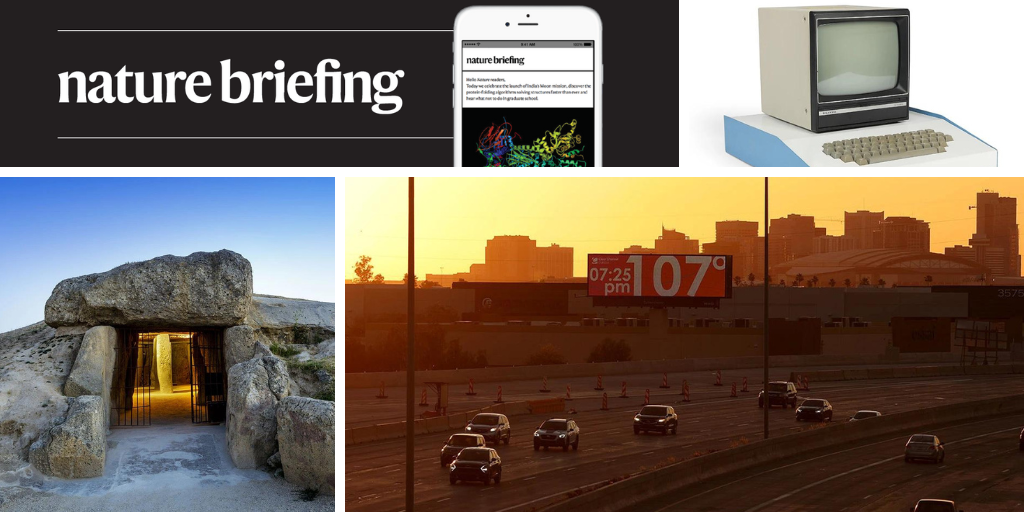Hello Nature readers, would you like to get this Briefing in your inbox free every day? Sign up here.

Archaeologists used laser scans and diagrams from earlier excavations to investigate the construction of the Dolmen of Menga.Credit: Cavan Images/Getty
The Neolithic farmers and herders who built a massive stone chamber in southern Spain nearly 6,000 years ago seem to have possessed a good rudimentary grasp of physics, geometry, geology and architectural principles. Using data from a high-resolution laser scan, as well as unpublished photos and diagrams from earlier excavations, archaeologists pieced together a probable construction process for the monument known as the Dolmen of Menga. “They understood how to fit together huge blocks of stone” with “a precision that would keep the monument intact for nearly 6,000 years”, says archaeologist and study co-author Leonardo García Sanjuán. “There’s no way you could do that without at least a basic working knowledge of science.”
Reference: Science Advances paper
Extreme heat kills more people on average in the United States than any other weather event, including hurricanes, floods and extreme cold. Scientists are working with cities to introduce low-tech cooling features to protect people. In the short term, public cooling stations and ‘too hot to work’ payments can help those who are most vulnerable. Redesigning cities to have more green, natural features that provide shade and release moisture is the next step. But gaps in local data can make it hard to assess which interventions work best
A third of Africa’s remaining great ape population is at risk from the impacts of mining for the transition metals needed to power the transition to green energy. Nearly 180,000 gorillas, chimpanzees and bonobos could be affected by current and planned mining for minerals such as lithium and cobalt, particularly in West Africa. To ameliorate the risk, mining companies need to share more of their data, say researchers, and take into account the impact of their work beyond the boundaries of their mines.
Reference: Science Advances paper
Image of the week

The Apple I computer went on sale in 1976 with a price tag of US$666.66.Credit: Christie’s Images Ltd 2024
An Apple I computer that sat in the office of Steve Jobs is one of a trove of science-history treasures from the estate of Microsoft mogul Paul Allen to be auctioned next month. Only about 200 Apple Is were ever made. Other items to bid on include astronaut Ed White’s NASA spacesuit and Albert Einstein’s 1939 letter alerting US president Franklin D. Roosevelt that the Germans had discovered fissionable uranium. (Nature | 6 min read)
Features & opinion
Brian May is a guitarist for the band Queen, an astrophysicist who works with NASA and a passionate advocate for badgers. Decades of amateur study has convinced him that the hypothesis that badgers (Meles meles) spread bovine tuberculosis (TB) to cows — which has prompted the culling of hundreds of thousands of badgers — is incorrect. He points to the government-sanctioned skin test as “the villain of the piece”, saying it’s “as little as 50% accurate”. “The fact that farmers are relying on this incredibly inaccurate test to remove cows from their precious herds and take them off to slaughter is a scandal,” says May.
Four scientists spoke to Nature about how to harness the power of artificial intelligence (AI) in research responsibly and ethically.
• AI is just a tool — it’s up to its users to consider how it might reinforce discrimination, says computer scientist Ross King, who helped create the Stockholm Declaration on AI for Science. “Already, it is a bit too late,” he warns.
• Don’t try to use AI to solve every problem, says computer scientist Suresh Venkatasubramanian, who helped to co-author the first US blueprint for an AI Bill of Rights. “Right now, we are in the hype cycle, in which no one’s talking about the limits of these tools,” he says.
• Computer scientist Nyalleng Moorosi has a “passion for data representation: that is, who is included in the data sets and how they are portrayed”. She co-founded the non-profit organization Deep Learning Indaba so that “Africans will be not only observers and receivers of advances in AI, but also active shapers and owners of those advances.”
• “I am concerned that Africa is being managed, against its will, as the least rewarded link in the global chain of the AI economy” as a source of training data or low-paid workers, says computer scientist Seydina Ndiaye, who has co-founded several information-technology companies on the continent. He calls for African-led AI development and for researchers globally to consider how the Africans who contributed data for AI models get to benefit from those systems.
On Friday, Leif Penguinson was hiding in the lush cypress swamp of First Landing State Park in Virginia. Did you find the penguin? When you’re ready, here’s the answer.
After a month spent forest bathing in Canada, I’ll soon be returning to Briefing towers in the UK. Please send me your tips for getting over jet lag (and keeping the family entertained on long journeys) — or any other feedback on this newsletter — to [email protected].
Thanks for reading,
Flora Graham, senior editor, Nature Briefing
With contributions by Sara Reardon
Want more? Sign up to our other free Nature Briefing newsletters:
• Nature Briefing: Microbiology — the most abundant living entities on our planet — microorganisms — and the role they play in health, the environment and food systems.
• Nature Briefing: Anthropocene — climate change, biodiversity, sustainability and geoengineering
• Nature Briefing: AI & Robotics — 100% written by humans, of course
• Nature Briefing: Cancer — a weekly newsletter written with cancer researchers in mind
• Nature Briefing: Translational Research — covers biotechnology, drug discovery and pharma


